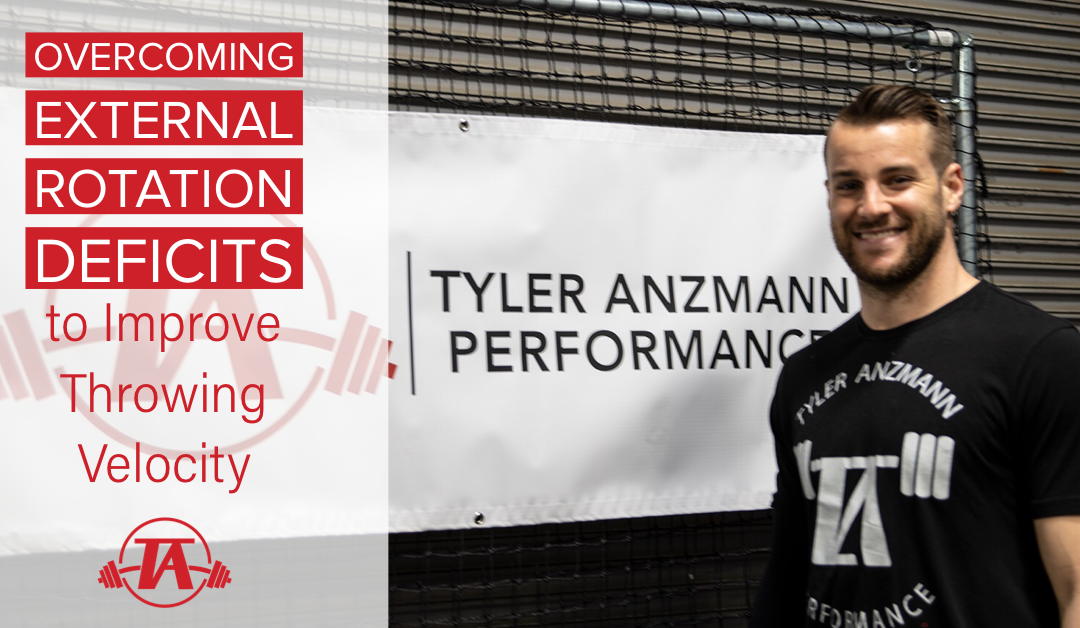We’ve all seen the still images of Aroldis Chapman, Chris Sale, or other guys with crazy layback, and thought, “Man, that must be the key to throwing hard!”
Well, it certainly helps, but it’s not the end-all-be-all.
Why It’s Advantageous
In a study of high and low velocity pitchers, average max external rotation was found to be 179 degrees and 166 degrees respectively (Matsuo et al., 2001).
This makes sense since more extreme layback can improve ball velocity because it provides a greater distance for acceleration forces to be applied to the baseball. This is why adaptations like GIRD can be beneficial. They allow greater external rotation range of motion (ROM) via humeral retroversion and may even help keep pitchers healthier.
How Do Some Pitchers Overcome a Relative Lack of Layback?
But, what if you don’t have crazy shoulder ROM? Are you never going to throw hard?
While it’s definitely worth improving areas of poor ROM (assuming they are not the result of bony blocks), there are ways to overcome a lack of external rotation.
Noah Syndergaard doesn’t have crazy layback ROM and he still throws hard. How does he do it?
He does it through a few ways.
- He has elite strength. More force production capabilities means that he can apply more force to the baseball even if there’s a smaller arc of motion.
- He has well above Major League average body weight. Major League pitchers have an average weight of 216 lbs (Hall, 2016), and he’s listed at 240 lbs (MLB.com). His bodyweight is a huge advantage for creating velocity due to the slope of the mound. The mound allows pitchers to use gravity to their advantage and greater body weight means more momentum down the slope, and more energy that can be transferred into the ball.
- He has elite lever length. Even though he may not have crazy ER, his arms are long enough that there is still a great distance for acceleration forces to be applied to the ball. Having long levers allows pitchers to use less ROM and still apply acceleration forces to the ball over a large arc of motion.
- He has elite movement sequencing and patterns. His hip/shoulder separation, horizontal abduction, and lead leg block are all elite. High level movement patterns and sequencing mean that a large amount of energy is created and then a high amount of that energy is transferred into the ball.
How Do You Improve Layback?
Well, layback is often mislabeled external rotation. While external rotation is part of it, layback is a combination of thoracic extension, scapular posterior tilt, and shoulder external rotation.
So, improving any or all of these pieces should help improve layback.
Thoracic Extension
Thoracic extension helps provide the pre stretch necessary for powerful thoracic flexion at ball release, which is associated with high ball velocity (Seroyer et al., 2010). Without the necessary ROM it’s not going to magically appear during your pitching delivery, so if it’s lacking give these a try:
Scapular Posterior Tilt
Scapular posterior tilt helps set the glenohumeral (ball and socket) joint up for safe and effective external rotation by helping keep the humeral head on the glenoid fossa. Without posterior tilt the glenohumeral joint will be forced to move without assistance from the scapula, which may increase the risk of shoulder injury (Paine et al., 2013).
Glenohumeral External Rotation
Once you have the other elements down, it’s worth improving glenohumeral external rotation if you are limited.
A tight pec minor can limit external rotation by putting the humerus in a more medially rotated starting position and putting the scapula in a more anteriorly tilted starting position. A bad starting position makes good movement more difficult, so releasing this area may be worth while.
Conclusion
Crazy amounts of laxity do not necessarily mean that a pitcher will throw hard, and a relative lack of laxity does not mean a pitcher will not. Athletes with laxity should make sure they are strong and stable through their full range of motion and probably don’t need to worry about improving ROM. However, if you’re an athlete who has mobility restrictions you can work on them as I discussed above. But, you should also make sure you do everything you can to set yourself up for success with high levels of strength, lean mass, and solid movement patterns and sequencing.
For a quick recap, check out this video:
If you’re interested in individualized programming to help you reach your velocity and performance goals, contact me here.
Resources
Matsuo, Tomoyuki & Escamilla, Rafael & Fleisig, Glenn & W. Barrentine, Steven & R. Andrews, James. (2001). Comparison of Kinematic and Temporal Parameters between Different Pitch Velocity Groups. Journal of Applied Biomechanics. 17. 1-13. 10.1123/jab.17.1.1.
Shane T. Seroyer, MD,* Shane J. Nho, MD, Bernard R. Bach, MD, Charles A. Bush-Joseph, MD, Gregory P. Nicholson, MD, and Anthony A. Romeo, MD (2010) The Kinetic Chain in Overhand Pitching Its Potential Role for Performance Enhancement and Injury Prevention. Sports Health.
Russ Paine and Michael L. Voight (2013) The Role of the Scapula. The International Journal of Sports Physical Therapy.
Noah Syndergaard Stats, Fantasy, and News. (2019) Retrieved from https://www.mlb.com/player/noah-syndergaard-592789
Hall, C (2016, Dec 27). MLB Players Packing on Muscle: Analysis of 144 years of reported weight of players. Retrieved from https://medium.com/@CQH/mlb-players-packing-on-muscle-analysis-of-144-years-of-reported-weight-of-players-b8f56afcda9b

